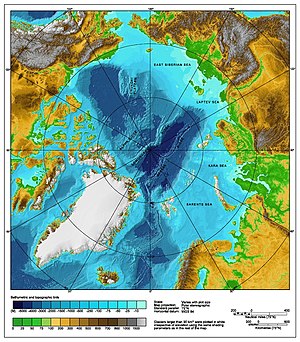
The Arctic consists of land, internal waters, territorial seas, exclusive economic zones (EEZs) and international waters above the Arctic Circle (66 degrees 33 minutes North latitude). All land, internal waters, territorial seas and EEZs in the Arctic are under the jurisdiction of one of the eight Arctic coastal states: Canada, Denmark (via Greenland), Finland, Iceland, Norway, Russia, Sweden and the United States.[1] International law regulates this area as with other portions of Earth.
Under international law, the North Pole and the region of the Arctic Ocean surrounding it are not owned by any country. The five surrounding Arctic countries are limited to a territorial sea of 12 nautical miles (22 km; 14 mi) and an exclusive economic zone (EEZ) of 200 nautical miles (370 km; 230 mi) adjacent to their coasts measured from declared baselines filed with the UN. The waters beyond the territorial seas and EEZs, that is, beyond 200 nautical miles (370 km; 230 mi) from the coastal states' baselines, are considered the "high seas" (i.e. international waters). The waters and sea bottom that is not confirmed to be extended continental shelf beyond the exclusive economic zones are considered to be the "heritage of all mankind." Fisheries in these waters can only be limited by international treaty. Exploitation of mineral resources on and below the seabed in these areas is administered by the UN International Seabed Authority.
Upon ratification of the United Nations Convention on the Law of the Sea (UNCLOS), a country has a ten-year period to make claims to an extended continental shelf which, if validated, gives it exclusive rights to resources on or below the seabed of that extended shelf area.[2] Norway, Russia, Canada, and Denmark launched projects to provide a basis for seabed claims on extended continental shelves beyond their exclusive economic zones.[3] The United States has signed, but not yet ratified the UNCLOS.[4][5]
The status of certain portions of the Arctic sea region is in dispute for various reasons. Canada, Denmark, Norway, Russia, and the United States all regard parts of the Arctic seas as national waters (territorial waters out to 12 nautical miles (22 km)) or internal waters. There also are disputes regarding what passages constitute international seaways and rights to passage along them. There was one single disputed piece of land in the Arctic—Hans Island—which was disputed until 2022 between Canada and Denmark because of its location in the middle of a strait.
- ^ "Arctic Council".
- ^ "United Nations Convention on the Law of the Sea (Annex 2, Article 4)". Retrieved 2007-07-26.
- ^ [1] Archived August 8, 2007, at the Wayback Machine
- ^ Drawbaugh, Kevin (October 31, 2007). "U.S. Senate panel backs Law of the Sea treaty". Reuter.
- ^ "President's Statement on Advancing U.S. Interests in the World's Oceans". Georgewbush-whitehouse.archives.gov. 2007-05-15. Retrieved 2012-01-10.